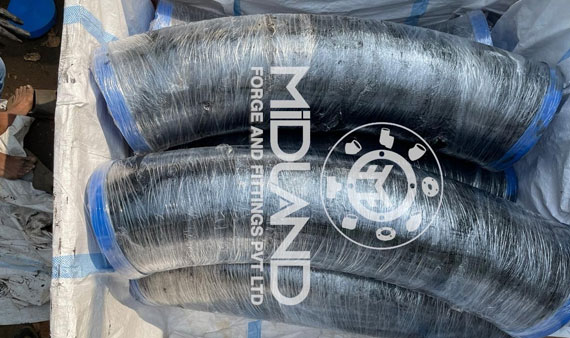- Home
- Buttweld Pipe Fittings
- Buttweld Pipe Bends
Buttweld Pipe Bends
Pipe Bends : Specifications | Materials | Types | Dimensions | Weight Chart | Tolerances | FAQ
Top ASME B16.9 1D, 1.5D, 2D, 3D, 5D, 8D, 10D Pipe Bend Manufacturer & Exporter – Delivering High-Quality Stainless Steel, Carbon Steel, Alloy Steel, and High Nickel Alloy Pipe Bends (Seamless & Welded, SCH 40 / SCH 80) to the UK, Canada, Singapore, Saudi Arabia, and Brazil.

Best Export Prices: sales@midlandforgefittings.com
At Midland Forge and Fittings Pvt. Ltd., we take pride in being a trusted name in the manufacturing of high-quality pipe bends for diverse industrial applications. With years of expertise, advanced technology, and a strong commitment to excellence, we deliver precision-engineered bends that ensure smooth fluid flow, reduce pressure drop, and enhance the durability of piping systems.
We manufacture a wide range of carbon, stainless, and alloy steel pipe bends that comply with global standards such as ASME, ANSI, DIN, and EN. Whether it’s long radius bends, short radius bends, 3D, 5D, or 10D bends, our products are built to withstand extreme temperatures, pressures, and corrosive environments. Each bend undergoes strict quality checks to ensure optimum performance, making us a reliable partner for the oil and gas, petrochemical, power generation, and water treatment industries.
Pipe bends are precision-engineered components used to change the direction of piping systems while maintaining smooth flow characteristics and minimizing pressure loss. Manufactured to meet international standards such as ASME, ANSI, DIN, and ISO, our pipe bends are available in a variety of radii including short radius (SR), long radius (LR), and custom bends up to 10D or more. Each bend undergoes rigorous quality control and non-destructive testing (NDT) to guarantee dimensional accuracy, superior surface finish, and compliance with client specifications.
Long Radius (LR) Bends Specifications, Sizes & Standards
Size Range – Seamless
Wall Thickness
Marking
Fitting Types
Size Range – Welded
Ends Connection
Manufacturing Standards
Materials
Size Range – Fabricated
Dimensional Standards
Testing
Surface Finish
Buttweld Pipe Bends – Materials, Grades & Standards
| Material Category | Grade | Standards (ASTM / ASME) | Typical Use/Application |
|---|---|---|---|
| Stainless Steel | 304 / 304L / 304H | ASTM A403 WP304/304L/304H | General purpose, corrosion resistance |
| 316 / 316L / 316H | ASTM A403 WP316/316L/316H | Marine & chemical applications | |
| 317 / 317L | ASTM A403 WP317/317L | High corrosion resistance | |
| 321 / 321H | ASTM A403 WP321/321H | High temperature, stabilized | |
| 347 / 347H | ASTM A403 WP347/347H | High-temp pressure systems | |
| 904L | ASTM A403 WP904L / B625 | Acid handling, sulfuric environments | |
| 254 SMO | ASTM A403 / B366 | High chloride environments | |
| Carbon Steel | A234 WPB / WPC | ASTM A234 | Pressure piping & general piping systems |
| A420 WPL6 | ASTM A420 | Low temperature services | |
| Alloy Steel | A234 WP1 / WP5 / WP9 | ASTM A234 | High-temp & pressure pipelines |
| A234 WP11 / WP22 | ASTM A234 | Steam lines & refineries | |
| A234 WP91 | ASTM A234 | Power generation, high performance | |
| Duplex Steel | UNS S31803 / S32205 | ASTM A815 / A790 | Corrosion & high strength use |
| Super Duplex Steel | UNS S32750 / S32760 | ASTM A815 / A790 | Offshore, seawater applications |
| Nickel Alloys | Nickel 200 / 201 | ASTM B366 / B162 | Alkali & chemical processing |
| Inconel 600 / 625 / 718 | ASTM B366 | Heat exchangers, aerospace | |
| Incoloy 800 / 825 | ASTM B366 | Petrochemical & chemical processing | |
| Hastelloy C22 / C276 | ASTM B366 | Severe corrosion resistance | |
| Monel 400 / K500 | ASTM B366 | Seawater, chemical industries | |
| Alloy 20 | ASTM B366 | Sulfuric acid services | |
| Nimonic 75 / 80A | ASTM B366 / B637 | High-temp applications | |
| Copper Nickel | Cu-Ni 90/10 / 70/30 | ASTM B466 / B467 | Marine systems, seawater service |
| Titanium | Grade 2 / Grade 5 | ASTM B363 | Lightweight, corrosion resistance |
| Aluminium | 6061 / 5083 | ASTM B361 | Low-pressure, non-corrosive piping |
Request for an Immediate Offer?
We will reply you in 2 hours during support time!
Conctact Now!Dimensions of Buttweld Pipe Bends

